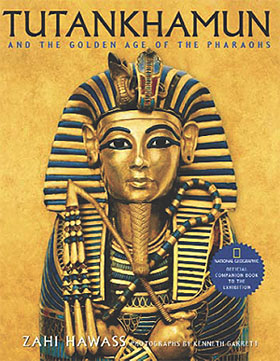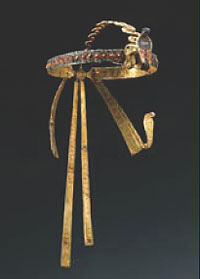A Golden Age That Never Ends
 One of the multicolored, gold coffins that King Tut's mummy was placed inside during his burial graces the cover of the official companion book to the traveling exhibit.
One of the multicolored, gold coffins that King Tut's mummy was placed inside during his burial graces the cover of the official companion book to the traveling exhibit. Photo credit: Kenneth Garrett, "Tutankhamun and The Golden Age of the Pharaohs," Official Companion Book © National Geographic Society
High-resolution version of this photo.
The ancient Egyptian boy-king, Tutankhamun, may have ruled for only 10 years some 3,000 years ago, but his name lives on today through the spectacular artifacts discovered in his tomb in 1922 by English archaeologist Howard Carter.
For the first time in 25 years, the antiquities found in King Tut's tomb are back on tour in the USA, giving a whole new generation of Americans a chance to learn more about the early Egyptians, a civilization that flourished for 2,000 years and gave us great architectural wonders like the pyramids and the sphinx.
By viewing the exhibit's many treasures, which include elaborately jeweled vessels, a golden dagger and a gold falcon-shaped collar found on the mummy of Tutankhamun, we can see how advanced the Egyptians were at metalworking.
But gold wasn't the only metal used in ancient Egypt. Most everyday items like water vessels, hand mirrors, razors and the chisels used to smooth the limestone blocks of the great pyramids, were made of copper, which, like gold, can be shaped and bent into many useful forms when it is hot or cold.
Copper was instrumental in another area of Egyptian expertise - agriculture. Copper picks and hoes were used to harvest crops both in this world and the next. Some 168 miniature copper farming implements - buried with King Tut to serve him in the afterlife - were recovered from his tomb.
 A golden diadem, inlaid with colored glass and semiprecious stones, got its coloring from minerals like copper crushed into a fine powder. Copper was used to create a blue glaze that was popular during King Tut's reign and is shown here on the head of the cobra.
A golden diadem, inlaid with colored glass and semiprecious stones, got its coloring from minerals like copper crushed into a fine powder. Copper was used to create a blue glaze that was popular during King Tut's reign and is shown here on the head of the cobra. Photo credit: Andreas F. Voegelin, Antikenmuseum Basel and Sammlung Ludwig
High-resolution version of this photo.
While it was probably unknown to them at the time, copper's naturally antimicrobial properties may have helped the Egyptians produce bigger and better crops. Research conducted in the early 20th Century by Austrian forester Viktor Schauberger shows that copper ploughs (versus steel) promote healthier soil, reduce incidences of pests and increase crop yields.
Today, copper continues to help farmers across the world. Instead of tools, however, it is copper crystals and powders that are used to prevent fungal diseases in plants. The next time you raise a glass of Burgundy or Bordeaux, you can thank copper for protecting its grapes from mildew.
"Tutankhamun and The Golden Age of the Pharaohs," featuring 50 treasures from King Tut's tomb, along with more than 70 items from other Egyptian kingdoms, will tour the United States until 2007. Four cities will host the exhibit: Los Angeles, Fort Lauderdale, Chicago and Philadelphia. Cu
Resources:
U.S. Geological Survey Minerals Information
"Egyptian Faience" by Marie Parsons
The Virtual Egyptian Museum
Also in this Issue:
- A Golden Age That Never Ends
- The Dawn of a New Bronze Age
- Mother Nature's Masquerade
- New Generation of Artisans Discover Copper
